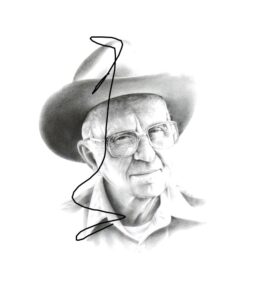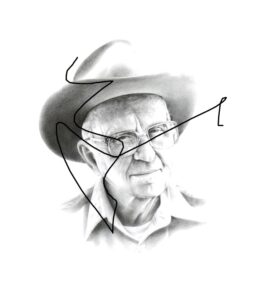Moonstruck Goat by Elsie Driggs

Image credit: Elsie Driggs (1898-1992), Moonstruck Goat, 1957, oil and pieced fabric on primed canvas, H. 16 x W. 16 inches, James A. Michener Art Museum. Museum purchase funded by Agnes and Robert Hagan.

About the Artwork
Elsie Driggs created this collage in 1957. According to Driggs, her inspiration for turning to the collage technique was the sight of her young daughter playing with paint and torn paper. Using oil paints and pieces of canvas and burlap, Driggs composed Moonstruck Goat with simple shapes, muted colors, and a variety of textures.
The angular shapes of the goat’s head fill most of the perfectly square canvas surface. An egg-shaped moon floats near its nose sharing the shallow, smooth sky with several jagged shapes below that suggest mountains. The goat’s oval eye appears to be half open and quietly echoes the shape and tilt of the moon. Subdued colors—shades of gray, yellow, green, maroon and the natural tans and browns of canvas and burlap—contrast with the jumbled puzzle pieces of fabric filling it’s head and neck. A variety of textures provide additional contrasts. The smoothly painted background heightens our perception of the rough textures and frayed edges and layers of burlap pieces and of the areas of impasto (thick paint).
This goat, with its head at an odd angle and its mouth partly open, appears to be looking at the moon. Could the goat be talking, or singing to it? Inside its purple head many rectangular shapes jostle for position like tile pieces in a half finished mosaic. The title, Moonstruck Goat, suggests several interpretations. “Moonstruck” can mean crazy, or dreamily romantic. Goats, known for their charm and playfulness, can also refer to victims (as in scapegoat), to lecherous men, and to anger (to get someone’s goat).
When Driggs created Moonstruck Goat, she was the wife of artist Lee Gatch and the mother of a young child. She lived with her family in a small, three-room stone house on Coon Path in Lambertville that needed repairs. In contrast to her previous life as an art student and a successful artist in New York City, Driggs now created art at her kitchen table far from galleries and the company of other artists. The technique of collage allowed her to stop and start her work frequently during the course of the day and to explore her subjects with spontaneity, humor, and imagination. As she states, “my time was shredded…..by working in collage, I could carry forward in stages….”
Looking Questions
- What do you see in this work? Identify all the details you find.
- Name all the textures you see in this image. What do these textures remind you of?
- What kinds of colors did Driggs use in her work? What do the colors suggest?
- What do you feel is the most important part of this artwork? Why?
- Do you think this is an abstract or realistic work of art? Explain your answer.
- Read and discuss the title, Moonstruck Goat. Does knowing the title change how you understand and respond to this artwork?
- What alternative title would you give this painting? Why?
- What words could describe the mood of this work? What do you see that communicates this mood?
- Does this painting remind you of anything? Explain your answer.
- Imagine changing the colors, shapes, or textures in Moonstruck Goat. Explain how your changes would change its mood and meaning.
- If you could tell a story about this work, what would it be?
About the Artist
Elsie Driggs was born in 1898 in Hartford, Connecticut. Known primarily as a Precisionist painter, Driggs, in the course of her long career, also did floral and figurative paintings in watercolors, pastels, and oils. After studying at the Art Students League and in Italy, she settled in New York City, where she enjoyed immediate success. During the 1920s, Driggs became associated with the Precisionists, also known as New Classicists or Immaculates, a group that painted the modern landscape of factories, bridges, and skyscrapers with geometric precision and almost abstract sparseness. Her most famous Precisionist painting was Pittsburgh (1926-27), inspired by her memories of the steel mills where her father, an engineer, had worked. This painting was subsequently purchased by Gertrude Vanderbilt Whitney in 1929 for the opening of the Whitney Museum of American Art in New York City.
During the 1930s, however, Driggs departed from Precisionism, producing more whimsical watercolors and figurative paintings, as well as murals for the Works Progress Administration (WPA). After marrying painter Lee Gatch, whose work she admired, Driggs moved to Lambertville, New Jersey in 1935 and devoted herself primarily to supporting her husband’s career and motherhood, a choice many female artists of her generation made. The couple purchased a small, run-down stone house which lacked indoor plumbing on Coon Path in Lambertville. Gatch used their rugged studio, while Driggs worked on the kitchen table. Their reclusive life in Lambertville motivated Driggs to draw upon her imagination for subjects and to experiment with new media, such as the pastel and watercolor collage. Although Gatch thrived in this rustic environment, Driggs, a sociable urbanite, felt constrained.
During the 1960s, however, Driggs resumed working actively, experimenting with mixed media constructions and figurative paintings in pastels and oils. After her husband’s death in 1968, she returned to New York City. Working until her death in 1992, Driggs was the most long-lived and productive of the Precisionist painters.
Activities
Language Arts
- Use your imagination to tell the story of the Moonstruck Goat, describing events in its life before, during, and after this scene.
- Read Winter Moon by Langston Hughes. Then, create a poem in response to this painting from the point of view of the goat.
Social Studies/Science
- What is some of the uses of the goat in various cultures and in history? Explore some of these areas including food, clothing, and religion.
- Research the moon in our solar system. What are its physical characteristics? What makes it unique from the other planets in our solar system? How many times have humans explored the moon? Write a report and present your findings to the class.
Visual Arts
- Create a collage of an animal using a variety of materials, techniques and textures: painting and tearing paper; constructing 3-D forms of paper; and using layers of fabrics and paint. Incorporate the elements of spontaneity and accident by playing with the materials and discovering what images or forms emerge.
- Study Dog Barking at the Moon by Joan Miró and Moonstruck Goat. Write a critical analysis of both works, and compare and contrast the two artists, styles and subjects. Which do you prefer? Why?
Performing Arts/Music
- What kinds of sounds and movements would a moonstruck goat make? Using recorded sounds, create a recorded soundscape and a dance piece based on this painted collage.
- Listen to works that reference the moon, including The Moonlight Sonata (1801) by Ludwig van Beethoven and Clair de Lune (“By The Light of The Moon”) by Claude Debussy.
Technology/Graphic Arts
- Create a portrait of an animal and the moon using photomontage, a digital approach to collage. Create a second photomontage of the same animal, this time with the sun. Consider the symbolic meanings of the sun and the moon and how they affect the colors, shapes, and textures of your compositions.
Related Resources
- Curriculum Packet: Elsie Driggs: The Quick and the Classical
- Museum Activity: Focus on Moonstruck Goat by Elsie Driggs
- Google Art Project: Moonstruck Goat by Elsie Driggs
- Google Art Project: Javits Center Abstracted by Elsie Driggs
- Bucks County Artists’ Database: Elsie Driggs
- Read and download more moon inspired activities you can do at home from a previous exhibition, The Color of the Moon.